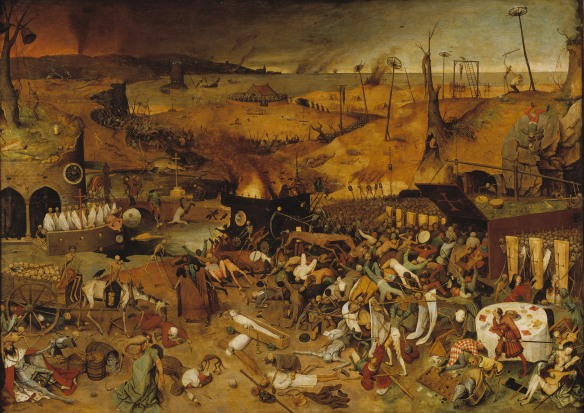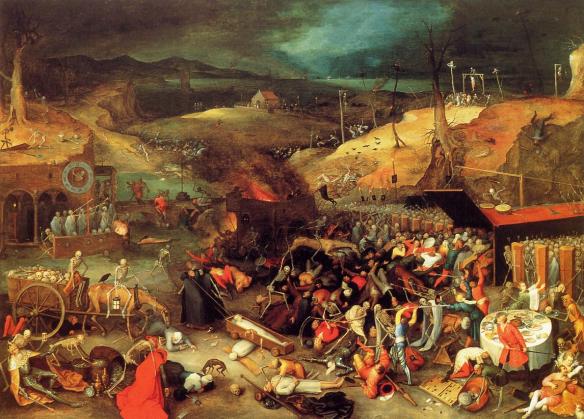To Vienna, to see the Bruegel exhibition at the Kunst Historisches Museum.
It’s the largest Bruegel show ever – two thirds of his paintings, and many of his sketches and the prints thereof. If you like Breugel and can make the trip, you should. Sixteenth century paintings don’t travel well, and it’s unlikely that so many of the Elder’s works will ever be assembled in one place again.
The first piece of art I ever took an interest in came on loan from the local library in Bebington. It was a tiny print of his Triumph of Death – just the kind of thing a morbid fourteen-year-old Wirralian would love. When I lived in Tabernas I made multiple trips to Madrid to visit the Prado – still my favourite art museum – and never failed to visit The Triumph, and Bosch’s Hay Wain, located nearby. Though the subject matter is in theory different, the two paintings have a lot in common… but I’ll save those observations for another time. When I last went to the Prado, in January of this year, The Triumph was gone – off for conservation work in Brussels. From there it went straight to Vienna, where I caught up with it yesterday.
The show is a bargain at 20 euros (which includes the rest of the museum, including a selection of art pieces drawn from the stacks by the American film director, Wes Anderson, and his partner – some of which are fascinating). But beware! There are big crowds at the Bruegel show, and you have to buy a ticket with a specified entrance time. I’d planned to spend two days at the Museum, but on the day I arrived, Bruegel was sold out. On the second day I couldn’t get in until 15:50 hrs. Usually the Museum closes at 18:00, but fortunately it was a Thursday, when the place stays open till 21:00. (In theory you can jump the queue by paying 30 euros, but in fact you can’t – the queue-jumper tickets are limited, and on both days were sold out.)
The exhibition begins at the beginning with early landscape drawings. The first painting is The Drunk Cast into the Pigsty, borrowed from a private collection (so if you don’t see it here, you may never see it at all). Next come pastoral scenes painted much later: including Hunters in the Snow, a lovely painting full of irony: two hunters with their posse of 13 dogs return with a single dead fox to show for their efforts. These are the famous winter paintings which include much ice-skating. After the prints of seven vices and seven virtues (which you could spend many hours on), more big paintings appear – The Battle Between Carnival and Lent and Childrens’ Games. These, I learned, are called “wimmelbild” – busy pictures. You probably know them both (they are quite famous, and part of the Museum’s permanent collection).

After several seafaring prints and paintings (the Elder was clearly knowledgeable about how ships were built and sailed) we enter a room which features two more large paintings: The Triumph, and Dulle Grillet. The catalogue gets a bit forlorn at this point, as the exhibition wasn’t able to include The Fall of The Rebel Angels, which like the other two is hugely influenced by Bosch. Why The Fall wasn’t included isn’t clear. Some of Breugel’s paintings – such as The Blind Leading The Blind – are too frail to travel. Perhaps this was the case with The Fall, which remains in Brussels (however, The Sermon of John the Baptist was denied an export license by the Hungarian authorities – it remains in a private collection, so we may never get to see it at all).
But what wonders The Triumph and Dulle Grillet are! Both were recently restored at the same place, and the work done is marvellous. The colours in The Triumph are much improved; its vision of multiple skeletons rampaging across a ruined landscape, stabbing, hanging, murdering, catching humans in nets or driving them into a hideous box, is clearer and more timely than it’s ever been. As the catalogue observes, by the standards of the sixteenth century, this is a very odd painting. Unlike Bosch’s Last Judgement (which I saw at the Theatre Museum the same day), there is no God and there are no angels: no one escapes death, no one is found worthy of heaven, all are doomed. For some reason this painting isn’t described as a “wimmelbild” although it certainly looks like one.
The Triumph of Death is a very contemporary painting. I love and admire it still, and yet… I think I admire Dulle Grillet even more. This – using a similar colour palate and technique – depicts the harrowing of Hell, by an army of women, led by the eponymous Mad Margaret. I’m not a Christian and so won’t attempt any theological explanation. All I know about the harrowing of Hell comes from Caryl Churchill’s great play Top Girls, in which D.G. recounts invading and ransacking the Devil’s kingdom. She is the largest character to appear in any Bruegel painting yet – with a metal helmet, lugging a sword, a knife, and much booty, including a frying pan. Again, there is no judgement or redemption in the painting: just a nightmare Boschian landscape full of monsters, and a band of women, led by Margaret, battling the monsters and the men.
I could have spent a day looking at just these two paintings. But the crowds were thick, and the next room presented a sight almost as tremendous: two paintings of the Tower of Babel. The large one, perhaps slightly more famous and familiar, is part of the Museum’s permanent collection. The smaller painting, on loan from Rotterdam, depicts a tower twice as high (you can tell from the size of the tiny figures at work on the massive structures). Either painting takes the viewer’s breath away. If you would like to see them side by side, make haste to the Kunst Historisches Museum.
The exhibition winds down with Peasant Wedding and Peasant Dance, paintings in which the landscape and backdrop give way to larger, foreground characters. Near the end is another small painting: the two chained monkeys, borrowed from Berlin, with a fascinating side display showing the stages in which the artist created the work.
Seeing the paintings all together in one place enables one to make connections which might otherwise be missed. Do the two monkeys reappear in a window in Hell, looking out over the battle of women against all in Dulle Grillet? A sightless face-mask appears at least twice: worn by a child in a window in Children’s Games, and again by a skeleton, pouring away wine (no longer needed!) in The Triumph of Death.
If I could wish for anything (besides all the missing Bruegels), it would be for the exhibition to include one of two copies of The Triumph, made, perhaps, by the painter’s nephew Jean. Both were done around the turn of the century, and reside in Gratz and Lichtenstein, I think. They are not exact copies: a man in a blue robe, captured by a skeleton, is depicted with a red robe in the re-makes – so he is a Cardinal (his captor also wears a red Cardinal’s hat). It would be nice to see two or three Triumphs side by side! But this is the old guy’s exhibition, and it has its priorities.

Two notes about Vienna, where I had never been before. I was trepidatious about travelling there, since I speak no German, and even less Austro-Bavarian: but of course almost everyone I met spoke English, and was entirely welcoming. And in three days I didn’t see a single baseball cap. Not one. Is this a cultural sea-change?
The Bruegel exhibition ends on January 13. If you like the old guy, and can afford the trip, well, you just must go.
